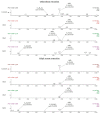Aspergillus flavus Growth Inhibition and Aflatoxin B1 Decontamination by Streptomyces Isolates and Their Metabolites
- PMID: 34066812
- PMCID: PMC8151643
- DOI: 10.3390/toxins13050340
Aspergillus flavus Growth Inhibition and Aflatoxin B1 Decontamination by Streptomyces Isolates and Their Metabolites
Abstract
Aflatoxin B1 is a potent carcinogen produced by Aspergillus flavus, mainly during grain storage. As pre-harvest methods are insufficient to avoid mycotoxin presence during storage, diverse curative techniques are being investigated for the inhibition of fungal growth and aflatoxin detoxification. Streptomyces spp. represent an alternative as they are a promising source of detoxifying enzymes. Fifty-nine Streptomyces isolates and a Streptomyces griseoviridis strain from the commercial product Mycostop®, evaluated against Penicillium verrucosum and ochratoxin A during previous work, were screened for their ability to inhibit Aspergillus flavus growth and decrease the aflatoxin amount. The activities of bacterial cells and cell-free extracts (CFEs) from liquid cultures were also evaluated. Fifty-eight isolates were able to inhibit fungal growth during dual culture assays, with a maximal reduction going down to 13% of the control. Aflatoxin-specific production was decreased by all isolates to at least 54% of the control. CFEs were less effective in decreasing fungal growth (down to 40% and 55% for unheated and heated CFEs, respectively) and aflatoxin-specific production, with a few CFEs causing an overproduction of mycotoxins. Nearly all Streptomyces isolates were able to degrade AFB1 when growing in solid and liquid media. A total degradation of AFB1 was achieved by Mycostop® on solid medium, as well as an almost complete degradation by IX20 in liquid medium (6% of the control). CFE maximal degradation went down to 37% of the control for isolate IX09. The search for degradation by-products indicated the presence of a few unknown molecules. The evaluation of residual toxicity of the tested isolates by the SOS chromotest indicated a detoxification of at least 68% of AFB1's genotoxicity.
Keywords: actinobacteria; biodegradation; detoxification; enzymes; fungi; mycotoxins.
Conflict of interest statement
The authors declare no conflict of interest. The funders had no role in the design of the study; in the collection, analysis, or interpretation of data; in the writing of the manuscript, or in the decision to publish the results.
Figures









Similar articles
-
Isolation of Bacillus spp. from Thai fermented soybean (Thua-nao): screening for aflatoxin B1 and ochratoxin A detoxification.J Appl Microbiol. 2008 May;104(5):1495-502. doi: 10.1111/j.1365-2672.2007.03700.x. Epub 2008 Jan 9. J Appl Microbiol. 2008. PMID: 18194245
-
Minimizing Ochratoxin A Contamination through the Use of Actinobacteria and Their Active Molecules.Toxins (Basel). 2020 May 5;12(5):296. doi: 10.3390/toxins12050296. Toxins (Basel). 2020. PMID: 32380688 Free PMC article.
-
Efficacy of the antifungal metabolites of Streptomyces philanthi RL-1-178 on aflatoxin degradation with its application to prevent aflatoxigenic fungi in stored maize grains and identification of the bioactive compound.World J Microbiol Biotechnol. 2022 Nov 24;39(1):24. doi: 10.1007/s11274-022-03470-7. World J Microbiol Biotechnol. 2022. PMID: 36422721
-
Impact of Volatile Organic Compounds on the Growth of Aspergillus flavus and Related Aflatoxin B1 Production: A Review.Int J Mol Sci. 2022 Dec 8;23(24):15557. doi: 10.3390/ijms232415557. Int J Mol Sci. 2022. PMID: 36555197 Free PMC article. Review.
-
Therapeutic detoxification of quercetin for aflatoxin B1-related toxicity: Roles of oxidative stress, inflammation, and metabolic enzymes.Environ Pollut. 2024 Mar 15;345:123474. doi: 10.1016/j.envpol.2024.123474. Epub 2024 Feb 1. Environ Pollut. 2024. PMID: 38309422 Review.
Cited by
-
Effect of Streptomyces roseolus Cell-Free Supernatants on the Fungal Development, Transcriptome, and Aflatoxin B1 Production of Aspergillus flavus.Toxins (Basel). 2023 Jun 30;15(7):428. doi: 10.3390/toxins15070428. Toxins (Basel). 2023. PMID: 37505697 Free PMC article.
-
Screening and identification of an aflatoxin B1-degrading strain from the Qinghai-Tibet Plateau and biodegradation products analysis.Front Microbiol. 2024 May 1;15:1367297. doi: 10.3389/fmicb.2024.1367297. eCollection 2024. Front Microbiol. 2024. PMID: 38751722 Free PMC article.
-
Characterization and genomic analysis of Bacillus megaterium with the ability to degrade aflatoxin B1.Front Microbiol. 2024 Aug 7;15:1407270. doi: 10.3389/fmicb.2024.1407270. eCollection 2024. Front Microbiol. 2024. PMID: 39171271 Free PMC article.
-
Effectiveness of Volatiles Emitted by Streptomyces abikoensis TJGA-19 for Managing Litchi Downy Blight Disease.Microorganisms. 2024 Jan 17;12(1):184. doi: 10.3390/microorganisms12010184. Microorganisms. 2024. PMID: 38258010 Free PMC article.
-
Application of antifungal metabolites from Streptomyces philanthi RL-1-178 for maize grain coating formulations and their efficacy as biofungicide during storage.World J Microbiol Biotechnol. 2023 Apr 12;39(6):157. doi: 10.1007/s11274-023-03604-5. World J Microbiol Biotechnol. 2023. PMID: 37043017
References
-
- Oliveira C.A.F., Bovo F., Humberto C., Vincenzi A., Ravindranadha K. Aflatoxins—Recent Advances and Future Prospects. InTech; Rijeka, Croatia: 2013. Recent Trends in Microbiological Decontamination of Aflatoxins in Foodstuffs.
-
- Masood M., Iqbal S.Z., Asi M.R., Malik N. Natural occurrence of aflatoxins in dry fruits and edible nuts. Food Control. 2015;55:62–65. doi: 10.1016/j.foodcont.2015.02.041. - DOI
-
- Azzoune N., Mokrane S., Riba A., Bouras N., Verheecke C., Sabaou N., Mathieu F. Contamination of common spices by aflatoxigenic fungi and aflatoxin B1 in Algeria. Qual. Assur. Saf. Crop. Foods. 2016;8:137–144. doi: 10.3920/QAS2014.0426. - DOI
Publication types
MeSH terms
Substances
Supplementary concepts
Grants and funding
LinkOut - more resources
Full Text Sources
Research Materials
Miscellaneous

